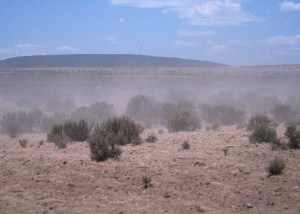Wind ErosionThe entire solid surface of the Earth is subject to wind erosion. It is the balance between the driving force of the wind and the resistance of the surface that ultimately determines whether surface materials are detached and transported away. Factors affecting wind erosionThe ability of the wind to erode the surface is determined by two factors, air density and wind velocity. The erosive power of the wind (E) is given as: E = V3ρ where V = wind velocity, and ρ = air density. Density has relatively little impact on the power of the wind. The erosive force of the wind is primarily related to its velocity. Its importance is seen as erosive power varies with the third power of velocity. For instance, a doubling of the wind velocity increases the erosive power by 8 fold while a tripling of velocity produces a 27 fold increase. Figure 20.2 Wind erosion on rangeland in New Mexico. (Courtesy NRCS) The roughness length of the surface (z0), a parameter based on the size and distance between objects in a group, has a critical control over the velocity of the wind. Grass, shrubs, and trees, all impart a drag on the wind to reduce its erosive force. Vegetation also acts to bind soil particles to the surface. A surface without a cover of vegetation exposes soil to the direct force of the wind making erosion more effective. Thus, dry regions lacking a protective cover of vegetation display the effects of wind erosion more than humid climates.
The cohesiveness of surface materials affects the resistance of the surface to erosion. Clay particles exhibit a greater degree of cohesiveness than sand. Clay-rich soils tend to resist erosion by wind more than less cohesive materials. Thus, clays require a much higher threshold velocity for detachment than one would expect. Cohesiveness may be provided by a cementing agent as well. Calcium carbonate and other salts common to desert regions deposited in interparticle voids harden and bind particles together.
|
||||||||||||||||||

